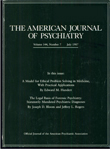Disorders of Personality—DSM-IV and Beyond, 2nd ed.
Theodore Millon has been one of the preeminent scholars of our time in systematically classifying, understanding, and explaining “disorders of personality.” In this most recent articulation of his thinking, in collaboration with Roger Davis and contributing associates, Millon succeeds in bringing as comprehensive a review to the subject matter as one can imagine. Indeed, the book takes us beyond simple taxonomies and classifications. Millon and his associates constantly argue for a dynamic, integrative, and systems perspective of personality rather than a narrow binary disease or medical model that reduces personality and its disorders to a static, pessimistic view for understanding our human nature.
This book will not please the strict polemicist, empiricist, or, for that matter, the strict clinician, who insists on one approach that is best or preferred. “As scientists, we are called on not merely to record behavior in this or that domain, but to explain it” (p. 9). This is one of many sage arguments for a systemic versus a linear, mechanistic model. Millon and his associates are keenly aware of our penchant as social scientists, theoreticians, and clinicians to adopt one perspective to the exclusion of considering each others' perspectives and to indulge in either-or polarities. Succinctly, they state, “Once a particular level [i.e., level of data] is chosen, it leads to conceptualizations and conclusions that do not readily translate into the vocabulary of others.” Although this book is in part about taxonomies and classifications, and Millon and his collaborators allow for their importance, they argue that personality cannot and should not be reduced to them. Rather, the primacy and complexities of a person must be understood and assessed. A “short paragraph” can do it better than a short diagnostic label.
The book does not lend itself to light bedtime reading. Disorders of Personality is a scholarly and sophisticated text of more than 750 double-column pages in fine print. It covers the entire field of personality disorders, spanning domains from theory through taxonomy, assessment, and intervention. The book provides a useful summary of the main personality theorists, starting with the Greek humoral theorists and their adherents over the centuries, through modern students of personality such as Sheldon and Sjobring, and right up to modern clinical investigators such as Kernberg and Gunderson. Nevertheless, homage is paid to lesser known lights (at least to me), such as Hirt, Meumann, Kahn, and Tramer, who, like their predecessors and successors, pick up on theories of activity-passivity, self-other, and pain–pleasure-directed polarities that we (including Millon and his associates) to this day consider in our empirical and clinical approaches to understanding personality.
The book reveals an extraordinary capacity to delve interchangeably into the empirical/taxonomic, clinical, conceptual, and treatment complexities of understanding personality and personality disorders. Millon and associates quite eloquently expound on the interactive-integration and biosocial-learning model of Theodore Millon. They argue that biological and psychological factors are not “unidirectional” and that one can profoundly affect the other.
Disorders of Personality is imaginatively organized by categorizing the personality disorders by degree of severity and core features of the groupings—thus reviewing sequentially 1) pleasure-deficient personalities, 2) interpersonally imbalanced personalities, 3) intrapsychically conflicted personalities, and 4) structurally defective personalities. Although the book is committed to avoiding homogeneous categorization of personality disorders and types, it also elaborates on the diversity and multiplicity of subtypes in each category. The chapters on specific personality disorders follow the same useful organization as the foundation chapters. Various theoretical perspectives are offered, classified, and described lucidly, sometimes with more clarity than their original proponents. This is especially the case when Millon et al. parsimoniously review narcissistic and borderline personality disorders, free of the convoluted terms and concepts originally employed by the main contemporary theorists addressing these conditions.
This is truly a balanced book, comprehensively covering a wide terrain. The balanced presentation allows the reader to readily assume the challenge by Millon and his associates to integrate the varying perspectives of personality disorders. One can read the book in its entirety and be comprehensively informed about the complexities of personality disorders, or one can adopt this textbook as a useful reference to selectively research various aspects of theory, classification, assessment, or treatment. In either case, this is a book that recommends itself to both beginning students and more advanced scholars who are in need of a definitive text on disorders of personality.



